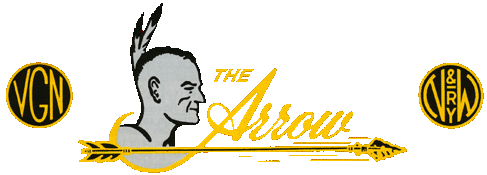| A Pictorial Review of N&W Motive Power: Last Installment - reprint Norfolk & Western Magazine; R. H. Persinger |
| |
Photo |
Class X1 were built in 1910 with 24-1/2" & 39" x 30" cylinders, 56" drivers, weighted 376,800 lbs, and exerted 83,615 lbs. tractive force compound with 200 lb. boiler pressure. Later, the steam pressure was increased to 230 lbs. increasing the maximum tractive effort to 90,176 lbs. compound. These Mallets were used in helper service on the Christiansburg grade as well as the Blueridge grade east of Roanoke until downgraded to hump engine service and eventually scrapped in 1934. (Norfolk and Western Railway Photograph Collection VPI&SU Libraries) |
| |
Photo |
Class Y1 were built by Baldwin in 1910 with the same cylinder, driver size, tractive effort and steam pressure specifications as the X1, but weighed 400,000 lbs. These engines initially operated out of Bluefield, WV, as well as in helper service and between Roanoke and Crewe on heavy freights. (Norfolk and Western Railway Photograph Collection VPI&SU Libraries) |
| |
Photo |
Class Z1a were built with 22" & 35" x 32" cylinders and 56-1/2" drivers and total weight of 427,000 lbs., while 225 lbs. steam pressure produced tractive effort of 75,830 lbs. compound, and 90,996 lbs. simple. The low-pressure cylinders had D-slide valves while the high-pressure cylinders had Baker valve gear. These engines were very similar to the C&O Class H-4. (Norfolk and Western Railway Photograph Collection VPI&SU Libraries) |
| |
Photo |
The Class Y2 were designed by N&W's Motive Power Department and some were built at Roanoke Shops while twenty were built by Baldwin during the war time emergency of WWI. Class Y2a, represented here by No. 1717, had its low-pressure cylinders bored out to 25" diameter instead of the Y2's 24-1/2", thus increasing steam pressure to 240 lbs. with tractive effort of 123,960 lbs. simple, 103,300 compund. All of the 1700 class had the air pumps mounted on the front of the smokebox. Later, several Y2a's were equipped with tender truck boosters for use in hump yard service. (Norfolk and Western Railway Photograph Collection VPI&SU Libraries) |
| |
Photo |
Class Y3a were built by ALCo, Richmond Works, in 1923 and were virtually identical to the Class Y3, except for their larger six-wheel tenders which held 16 tons of coal and 15,000 gallons of water. The air pumps were originally mounted on the front of the smokebox, but would be relocated at a later date. As built these Mallets had 25" & 39" x 32" cylinders, 57" drivers, 240 lbs. boiler pressure producing tractive effort of 121,600 lbs. simple, 101,300 lbs. compound. These engines were highly successful and served the N&W well. (Norfolk and Western Railway Photograph Collection VPI&SU Libraries) |
| |
Photo |
Class Y5, Nos. 2090 to 2109 were built by Roanoke Shops during 1930-32 originally with working boiler pressure of 280 lbs. which was increased to 300 lbs. yielding tractive effort of 152,206 lbs. simple, 126,836 compound. (Norfolk and Western Railway Photograph Collection VPI&SU Libraries) |
| |
Photo |
Class K1, Nos. 100 to 115, were the first mountain-type locomotives on the N&W. They were built by Roanoke Shops in 1916-17 with 29" x 28" cylinders, 70" drivers, weighed 347,000 lbs. and developed 57,200 lbs. tractive effort with their original 200 lbs. steam pressure, which was later raised to 220 lbs. resulting in 62,920 lbs. tractive effort. (Norfolk and Western Railway Photograph Collection VPI&SU Libraries) |
| |
Photo |
The N&W received ten USRA Heavy Mountain type locomotives in 1919 while under U.S. Government operation. These were Class K2, Nos. 116 to 125 and were built by Brooks with 28" x 30" cylinders, 69" drivers, weighed 352,000 lbs., 200 lbs. steam pressure with 58,000 lbs. tractive effort. (Norfolk and Western Railway Photograph Collection VPI&SU Libraries) |
| |
Photo |
In 1923 the N&W received twelve locomotives from Baldwin of the same basic design as the K2's. These locomotives, Nos. 126 to 137 were Class K2a and received the same modifications as their USRA cousins, including streamlining. (Norfolk and Western Railway Photograph Collection VPI&SU Libraries) |
| |
Photo |
Class K3, Nos. 200 to 209, were built by Roanoke Shops in 1926-27 intended for Time Freight Service, with 28" x 30" cylinders, 63" drivers, weighed 401,900 lbs., 225 lbs. steam pressure with 68,800 lbs. tractive effort. (Norfolk and Western Railway Photograph Collection VPI&SU Libraries) |
| |
Photo |
Class LC-1 consisted of 24 interchangeable single-unit 1600HP freight motor cabs, weighing 150 tons per unit, to operate as 3200HP double-unit locomotives weighing 300 tons, built in 1914-15 by Baldwin-Westinghouse. (Norfolk and Western Railway Photograph Collection VPI&SU Libraries) |
| |
Photo |
Class LC-2, Nos. 2512 to 2515, were four double-unit electric freight locomotives acquired from Alco-Westinghouse in 1924-25. (Norfolk and Western Railway Photograph Collection VPI&SU Libraries) |
| Norfolk & Western Railroad History, Part Four / from Railroad Gazette - Jim Cochran |
| The Tennessean - James Nichols |
| Column: Current News - Robert G. Bowers |
| Letters to the Editor - James Nichols; Jim Caldwell; Everett N. Young |
| Member's Photos - Mason Y. Cooper |
| |
Photo |
NS train #154, working with run-through Conrail power, rolls northward past the former N&W station at Whitepost, VA at 10:11 AM, January 4, 1994. (Mason Y. Cooper photo) |
| |
Photo |
Shortly before being opened for use, the new Vardo yard office looks on as NS C39-8 lays over in the yard. (Mason Y. Cooper photo) |
|

